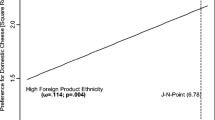Abstract
The nature of the impact of Country-of-Origin (CO) on purchase behavior is far from clear. A theoretical structure of the relationships underlying CO effects is tested using LISREL and the generalizability of the findings are assessed across respondents belonging to two different cultural groups (US-born and Greece- born) residing in the US. Responses provided by US-born respondents appear to fit the a priori theoretical model more closely than those provided by Greece-born respondents. The complexity of the acculturation process of Greece-born respondents is offered as the likely reason for this inter-group difference.
Access this chapter
Tax calculation will be finalised at checkout
Purchases are for personal use only
Preview
Unable to display preview. Download preview PDF.
Similar content being viewed by others
References
Baughn, C. Christopher and Attila Yaprak. 1991. Map** The Country–of–origin Literature: Recent Developments and Emerging Research Avenues.” Forthcoming in Product and Country Images (Tentative Title), Papadopoulos, N. and N. A. Heslop, eds.
Bentler, Paul M. and Douglas G. Bonett. 1980. “Significance Tests and Goodness–of–Fit in the Analysis of Covariance Structures.” Psychological Bulletin 88: 588–606.
Bilkey, W. J. and E. Nes. 1982. “Country of Origin Effects on Product Evaluations.” Journal of International Business Studies 8: 89–99.
Danes, J. E. and O. K. Mann. 1984. “Unidimensional Measurement and Structural Equations with Latent Variables. Journal of Business Research 12: 337–352.
Gerbing, David W. and John E. Hunter. 1988. ITAN: A Statistical Package for Item Analysis with Correlational Data including Multiple Groups Confirmatory Factor Analysis. Portland, OR: Portland State University.
Han, C. and V. Terpstra 1988. “Country of origin effects for uni-national and bi-national products.” Journal of International Business Studies: 235–254.
Hong, Sung-Tai and R. S. Wyer, Jr. 1 989. “Effects of Country-of-Origin and Product Attribute Information on Product Evaluation: An Information Processing Perspective.” Journal of Consumer Research 16 (Sept): 175–187
Joreskog, Karl G. and Dag Sorbom 1989. LISREL 7: User’s Reference Guide, First Edition. Moresville, IN: Scientific Software.
Lillis, Charles and Chem Narayana 1974. “Analysis of ‘Made In’ Product Images: An Exploratory Study.” Journal of International Business Studies 5 (Spring): 119–127.
Nagashima, Atkira 1977. “A Comparative ‘Made In’ Product Image Survey Among Japanese Businessmen.” Journal of Marketing 41 (July): 95–100.
Ozsomer, Aysegul and S. Tamer Cavusgil 1991. “Country-of-Origin Effects on Product Evaluations: A Sequel to Bilkey and Nes Review.” In Enhancing Knowledge Development in Marketing, Gilly, Mary, et al, eds. 1991 AMA Educators’ Proceedings: Volume 2. Chicago: American Marketing Association: 269–277.
Papadopoulos, N., L. A. Heslop and G. Bamossy 1989. “International competitiveness of American and Japanese Products.” In Dimensions of International Business (No. 2),Papadopoulos, N. ed. Ottawa, Canada: International Business Study Group, Carleton University.
Parameswaran, Ravi and Attila Yaprak 1987. “A Cross-National Comparison of Consumer Research Measures.” Journal of International Business Studies 18 (Spring): 35–49.
Pisharodi, R. Mohan and Ravi Parameswaran 1992. “Confirmatory Factor Analysis of a Country-of-Origin Scale: Initial Results.” In John F. Sherry, Jr. and Brian Sternthal, eds. Advances in Consumer Research. Volume XIX: 706–714.
Thorelli, H.B., J. Lim, and J. Ye 1989. “Relative Importance of Country-of-Origin, Warranty, and Retail Store Image on Product Evaluations.” International Marketing Review 6 (1): 35–46.
Author information
Authors and Affiliations
Editor information
Editors and Affiliations
Rights and permissions
Copyright information
© 2015 Academy of Marketing Science
About this paper
Cite this paper
Pisharodi, R.M., Parameswaran, R., Yaprak, A. (2015). Country-of-Origin Effects in a Cross-Cultural Setting. In: Sirgy, M., Bahn, K., Erem, T. (eds) Proceedings of the 1993 World Marketing Congress. Developments in Marketing Science: Proceedings of the Academy of Marketing Science. Springer, Cham. https://doi.org/10.1007/978-3-319-17323-8_64
Download citation
DOI: https://doi.org/10.1007/978-3-319-17323-8_64
Publisher Name: Springer, Cham
Print ISBN: 978-3-319-17322-1
Online ISBN: 978-3-319-17323-8
eBook Packages: Business and EconomicsBusiness and Management (R0)




